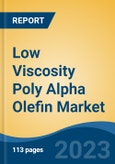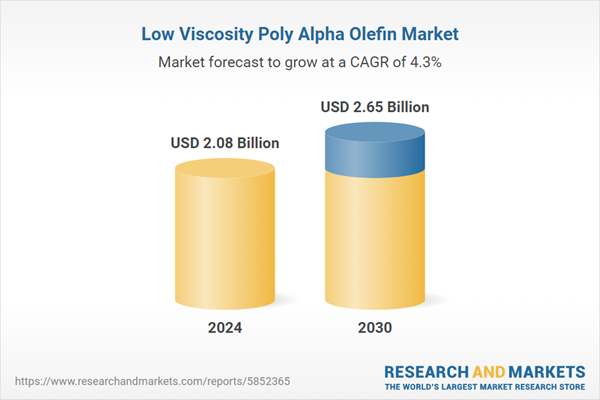Speak directly to the analyst to clarify any post sales queries you may have.
10% Free customizationThis report comes with 10% free customization, enabling you to add data that meets your specific business needs.
The global low viscosity poly alpha olefin market continues to exhibit promising growth prospects, underpinned by its critical role as a synthetic base oil in formulating high-performance lubricants and related products. Low viscosity poly alpha olefin, characterized by its superior properties including low volatility, exceptional low-temperature fluidity, enhanced thermal and oxidative stability, and a high viscosity index, serves as an effective alternative to conventional mineral oils. These attributes enable its widespread utilization across diverse applications, contributing to improved energy efficiency, reduced wear, and extended equipment life in demanding operational environments.
Primarily derived from the oligomerization of alpha olefins such as 1-decene or mixtures with 1-dodecene, low viscosity poly alpha olefin finds extensive demand in sectors such as automotive, industrial lubricants, cosmetics, and oil and gas. In the automotive industry, it is integral to engine oils, transmission fluids, and gear lubricants, aligning with global efforts to enhance vehicle efficiency and comply with emission standards. For instance, policies like the European Union's Euro 7 regulations emphasize reduced pollutant emissions, prompting the adoption of advanced synthetic lubricants that minimize friction and improve fuel economy. Similarly, the U.S. Environmental Protection Agency's fuel efficiency guidelines encourage the use of high-performance base oils to support sustainable transportation.
Key Market Drivers
Growing Demand from Automobile Industries
The increasing demand for low viscosity poly alpha olefin in the automobile sector is a significant driver, as it plays a pivotal role in formulating advanced lubricants that enhance engine performance, reduce emissions, and improve fuel efficiency. With the global automotive industry transitioning towards electrification and stricter environmental norms, synthetic base oils like low viscosity poly alpha olefin are essential for meeting the lubrication requirements of modern engines, transmissions, and electric vehicle components. Policies such as the U.S. Corporate Average Fuel Economy standards mandate higher efficiency, encouraging the use of lubricants with superior thermal stability and low volatility to minimize oil consumption and extend service intervals.In Europe, the Green Deal initiative promotes sustainable mobility, driving adoption in hybrid and electric vehicles where low viscosity formulations reduce energy losses in drivetrains. Facts from industry analyses indicate that low viscosity poly alpha olefin contributes to better shear stability in gear oils, supporting the durability of components under high-stress conditions. Emerging markets in Asia-Pacific, fueled by urbanization, see rising vehicle production, with policies like India's Faster Adoption and Manufacturing of Electric Vehicles scheme incentivizing advanced materials for battery cooling and lubrication systems.
In 2023, global automobile production reached nearly 94 million units, while the automotive components market was valued at USD 2 trillion, with exports contributing about USD 700 billion. India stood out as the fourth-largest vehicle producer worldwide, after China, the United States, and Japan, with an annual output of around 6 million vehicles. This rapid growth in vehicle production and components manufacturing is expected to fuel demand for Low Viscosity Poly Alpha Olefins (PAOs), as they play a critical role in high-performance lubricants, ensuring efficiency, durability, and reduced emissions in modern automotive engines.
Corporate commitments under the Science Based Targets initiative further accelerate integration, as automakers pledge to lower carbon footprints through efficient lubricants. Supporting data from engineering studies highlight its role in reducing friction coefficients, aligning with global efforts to combat climate change via the Paris Agreement. This driver is reinforced by collaborations between chemical suppliers and automotive OEMs to develop tailored solutions, ensuring compliance with standards like the American Petroleum Institute's specifications for engine oils.
Key Market Challenges
Fluctuation of Raw Material Prices
The low viscosity poly alpha olefin market faces challenges from volatile raw material prices, primarily driven by fluctuations in alpha olefin feedstocks like ethylene and propylene, which are influenced by crude oil dynamics and supply chain disruptions. Geopolitical tensions and global events exacerbate these issues, leading to inconsistent production costs and pricing pressures for manufacturers. Policies such as the U.S. Strategic Petroleum Reserve releases aim to stabilize energy markets, but short-term volatilities persist, as evidenced in supply chain reports highlighting dependencies on petrochemical hubs. This challenge impacts downstream industries, necessitating hedging strategies and alternative sourcing to maintain profitability.Key Market Trends
Intense Investment for Ongoing R&D
Significant investments in research and development are a prevailing trend in the low viscosity poly alpha olefin market, aimed at enhancing product performance and sustainability. Companies are focusing on advanced catalyst systems and process optimizations to improve yield and reduce environmental impact, supported by policies like the U.S. Department of Energy's funding for clean chemical technologies.Facts from innovation reports highlight developments in metallocene catalysts for precise molecular control, enabling tailored viscosities for specific applications. This trend fosters competitive differentiation and aligns with global green chemistry initiatives.
Key Market Players
- INEOS Group Holdings S.A.
- Exxonmobil Chemical International Services Limited
- Chevron Phillips Chemical Company LLC
- Shanghai Matex Chemicals Co.,Ltd.
- Dowpol Chemical International Corporation
- RB Products Holding, L.L.C.
Report Scope:
In this report, the Global Low Viscosity Poly Alpha Olefin Market has been segmented into the following categories, in addition to the industry trends which have also been detailed below:Low Viscosity Poly Alpha Olefin Market, By Type:
- Viscosity Less than 5 cSt
- Viscosity 5-10 cSt
Low Viscosity Poly Alpha Olefin Market, By Application:
- Aerosol
- Adhesives/Sealants
- Refining/Oil & Gas Production
- Lubricant & Grease Manufacturers
- Metal Working
- Cosmetics
- Mining
- Others
Low Viscosity Poly Alpha Olefin Market, By region:
- North America
- United States
- Mexico
- Canada
- Asia-Pacific
- China
- India
- South Korea
- Japan
- Australia
- Europe
- France
- Germany
- United Kingdom
- Italy
- Spain
- South America
- Brazil
- Argentina
- Colombia
- Middle East & Africa
- South Africa
- Saudi Arabia
- UAE
Competitive Landscape
Company Profiles: Detailed analysis of the major companies present in global Low Viscosity Poly Alpha Olefin market.Available Customizations:
With the given market data, the publisher offers customizations according to a company’s specific needs. The following customization options are available for the report.Company Information
- Detailed analysis and profiling of additional market players (up to five).
Table of Contents
Companies Mentioned
- INEOS Group Holdings S.A.
- Exxonmobil Chemical International Services Limited
- Chevron Phillips Chemical Company LLC
- Shanghai Matex Chemicals Co.,Ltd.
- Dowpol Chemical International Corporation
- RB Products Holding, L.L.C.
Table Information
| Report Attribute | Details |
|---|---|
| No. of Pages | 186 |
| Published | August 2025 |
| Forecast Period | 2024 - 2030 |
| Estimated Market Value ( USD | $ 2.08 Billion |
| Forecasted Market Value ( USD | $ 2.65 Billion |
| Compound Annual Growth Rate | 4.3% |
| Regions Covered | Global |
| No. of Companies Mentioned | 6 |









